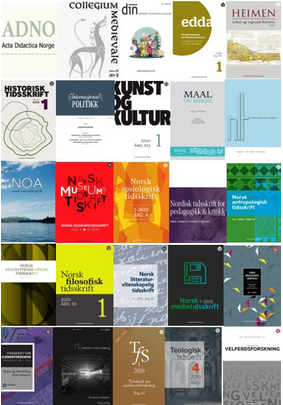Norwegian open journals in the social sciences and humanities
The Unit (from 2022: Sikt) consortium administered a model for transformation from subscription based journals to open access journals in Norwegian in the social sciences and humanities. A key element is that publishing in these journals should not require payment of an APC.
The consortium was established for a three-year period from 2018. After an evaluation (2020) it is extended for a new three-year period from 2021.
The consortium has firm commitment from the Norwegian Ministry of Education and Research. The consortium model is administered with support from the Norwegian Research Council and The Norwegian Association of Higher Education Institutions.
From 2022 the Norwegian Directorate for Higher Education and Skills is responsible for the consortium.
Background
A selection of Norwegian SSH journals has been granted support from the Norwegian Research Council for decades, initially to support print editions of traditional journals. These journals have in many cases been owned by academic societies and published in print by academic presses. The grants were given after a yearly application process.
The Norwegian Research Council announced in 2015 that its grants for SSH journals would from 2017 onwards only be awarded to open access journals. Most were print journals; just a couple of them were born open access. Nearly all journals managed to fulfil this demand: From 2017, 42 SSH journals, mostly in Norwegian, were made openly available based on grants not only from the Norwegian Research council as previously, but now also, to compensate for the loss of subscription costs, from The Ministry of Education and Research and the four largest universities in Norway. The latter agreed to give a sum comparable to their former subscription costs for these journals. The Ministry has requested that other higher education institutions also contribute funding equivalent to that of their previous subscription costs.
For the three year period from 2021 the consortium was extended, now with 28 journals receiving support.
The Humanities in Norway
White Paper to Stortinget (the Norwegian Parliament), March 2017
The changes which made this possible were probably the growing acceptance of open access and formalised by the launching of a white paper to Stortinget The Humanities in Norway in March 2017. This points out that the Government expects:
“that institutions take a well-founded approach to the costs of publication services. CERES (previously CRIStin) [now Unit] should be given a clear mandate to negotiate with publishers in consultation with the institutions. Those responsible for scientific journals should carefully consider their needs for support in the form of quality assurance and publishing services, and choose publishers or publishing platforms which offer high quality at a good price”
This means that Unit has a mandate that may be slightly different from earlier practice conducted by the Norwegian Research council. There is a white paper which regulates the process. Mainly there is a more articulated expectation to give priority to publishing in Norwegian. This is perhaps more relevant than before, as more and more research is performed in English, and this also applies for many open access publishers. Thus there is an aim to protect Norwegian, with approximately 5 million speakers, as a scholarly language. The Humanities in Norway point out:
“the requirement for open access should not negatively affect the volume of publishing in Norwegian in a transitional phase where the languages of small countries are in a vulnerable position.
[…]
The position of the Norwegian language as a medium for non-fiction prose texts requires special attention, in light of possible domain loss to English.”
It should be mentioned that Norwegian is understood by most Scandinavians so the open access research will benefit Swedes and Danes as well, and many of the Norwegian academic societies cooperate with their Scandinavian peers.
What journals are eligible?
- The journal should be ranked as scholarly on the Norwegian levels 1 or 2 in accordance with the bibliometric indicators used in Norway.
Norway has a system of evaluating scholarly practice, with two levels: 1 and 2. In short, a journal on level 1 is evaluated as an academic publication, using peer review. Level 2 shall in addition reach an international audience, and this level gives more publishing points to the scholar. To reach an international audience often results in an aim to publish in English, and critics say that this escalates the decline as Norwegian as an academic language.
- 2/3 of the authors should be affiliated to a Norwegian research institution and primarily address a Norwegian academic public.
- The journal must be viewed as central in its field.
Background for the process
Unit started the project when the white paper announced it a task, in March 2017. There were fundings in place, but the sum was not yet determined.
There was also a demand for approaching all institutions which may have interest for these SSH journals, partly from examining previous subscriptions, and this also includes all Norwegian research institutions in the SSH fields as well as minor institutions such as public libraries which may have had subscriptions to these journals.
There was a publishing committee in place when the process started. This committee, consisting of three deans from the humanities and three from the social sciences, had the task of interpreting the guidelines and the white paper and defining which of the journals who had made applications were eligible to receive grants, primarily based on the quality and impact of the journal.
Presentation delivered at the OpenAIRE workshop on Sustainable non-APC 2019: Norwegian open journals in SSH
